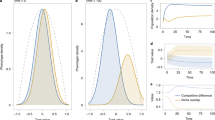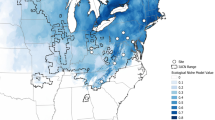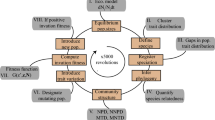Abstract
Ecologists have proposed that when interspecific competition is reduced, competition within a species becomes a potent evolutionary force leading to rapid diversification1. This view reflects the observation that populations invading species-poor communities frequently evolve broader niches2. Niche expansion can be associated with an increase in phenotypic variance3,4 (known as character release5), with the evolution of polymorphisms6,7,8,9, or with divergence into many species using distinct resources10,11,12,13 (adaptive radiation). The relationship between intraspecific competition and diversification is known from theory14,15, and has been used as the foundation for some models of speciation16,17,18,19,20. However, there has been little empirical proof that niches evolve in response to intraspecific competition. To test this hypothesis, I introduced cadmium-intolerant Drosophila melanogaster populations to environments containing both cadmium-free and cadmium-laced resources. Here I show that populations experiencing high competition adapted to cadmium more rapidly than low competition populations. This provides experimental confirmation that competition in a population can drive niche expansion onto new resources for which competition is less severe.
This is a preview of subscription content, access via your institution
Access options
Subscribe to this journal
Receive 51 print issues and online access
$199.00 per year
only $3.90 per issue
Buy this article
- Purchase on Springer Link
- Instant access to full article PDF
Prices may be subject to local taxes which are calculated during checkout


Similar content being viewed by others
References
Simpson, G. G. The Major Features of Evolution (Columbia Univ. Press, New York, 1954).
Werner, T. K. & Sherry, T. W. Behavioral feeding specialization in Pinaroloxias inornata, the “Darwin's Finch” of Cocos Island, Costa Rica. Proc. Natl Acad. Sci. USA 84, 5506–5510 (1986).
Van Valen, L. Morphological variation and width of ecological niche. Am. Nat. 49, 377–389 (1965).
Lister, B. C. The nature of niche expansion in West Indian Anolis lizards. I: ecological consequences of reduced competition. Evolution 30, 659–676 (1976).
Grant, P. R. Convergent and divergent character displacement. Biol. J. Linn. Soc. 4, 39–69 (1972).
Robinson, B. W. & Schluter, D. in Adaptive Genetic Variation in the Wild (eds Mousseau, T., Sinervo, B. & Endler, J. A.) 65–94 (Oxford Univ. Press, New York, 2000).
Gislason, D., Ferguson, M. M., Skulason, S. & Snorrason, S. S. Rapid and coupled phenotypic and genetic divergence in Icelandic arctic char (Salvelinus alpinus). Can. J. Fish. Aquat. Sci. 56, 2229–2234. (1999).
Knerer, G. & Atwood, C. E. Diprionid sawflies: polymorphism and speciation. Science 179, 1090–1099 (1973).
Meyer, A. Ecological and evolutionary consequences of the trophic polymorphism in Cichlasoma citrinellum (Pisces: Cichlidae). Biol. J. Linn. Soc. 39, 279–299 (1990).
Fryer, G. & Iles, T. D. The Cichlid Fishes of the Great Lakes of Africa (Oliver and Boyd, London, 1972).
Kambysellis, M. P. & Craddock, E. M. in Molecular Evolution and Adaptive Radiation (eds Givnish, T. J. & Sytsma, K. J.) 475–509 (Cambridge Univ. Press, New York, 1997).
Lack, D. Darwin's Finches (Cambridge Univ. Press, Cambridge, 1947).
Schliewen, U. K., Tautz, D. & Paabo, S. Sympatric speciation suggested by monophyly of crater lake cichlids. Nature 368, 629–632 (1994).
Wilson, D. S. & Turelli, M. Stable underdominance and the evolutionary invasion of empty niches. Am. Nat. 127, 835–850 (1986).
Roughgarden, J. Evolution of niche width. Am. Nat. 106, 683–718 (1972).
Rosenzweig, M. L. Competitive Speciation. Biol. J. Linn. Soc. 10, 275–289 (1978).
Dieckmann, U. & Doebeli, M. On the origin of species by sympatric speciation. Nature 400, 354–357 (1999).
Doebeli, M. A quantitative genetic competition model for sympatric speciation. J. Evol. Biol. 9, 893–909 (1996).
Gibbons, J. R. H. A model for sympatric speciation in Megarhyssa (Hymenoptera: Ichneumonidae): competitive speciation. Am. Nat. 114, 719–741 (1979).
Drossel, B. & McKane, A. Competitive speciation in quantitative genetic models. J. Theor. Biol. 204, 467–478 (2000).
Shirley, M. D. F. & Sibly, R. M. Genetic basis of a between-environment trade-off involving resistance to cadmium in Drosophila melanogaster. Evolution 53, 826–836 (1999).
Rainey, P. B. & Travisano, M. Adaptive radiation in a heterogeneous environment. Nature 394, 69–72 (1998).
Hori, M. Frequency-dependent natural selection in the handedness of scale-eating cichlid fish. Science 260, 216–219 (1993).
Benkman, C. W. Are the ratios of bill crossing morphs in crossbills the result of frequency-dependent selection? Evol. Biol. 10, 119–126 (1996).
Prokopy, R. J., Diehl, S. R. & Cooley, S. S. Behavioral evidence for host races in Rhagoletis pomonella. Oecologia 76, 138–147 (1988).
Feder, J. L., Reynolds, K., Go, W. & Wang, E. C. Intra- and interspecific competition and host race formation in the apple maggot fly, Rhagoletis pomonella (Diptera: Tephritidae). Oecologia 101, 416–425 (1995).
Jones, C. D. The genetic basis of Drosophila sechellia's resistance to a host plant toxin. Genetics 149, 1899–1908. (1998).
Fisher, R. A. The Genetical Theory of Natural Selection (Dover, New York, 1958).
Coyne, J. A., Barton, N. H. & Turelli, M. Perspective: A critique of Sewall Wright's shifting balance theory of evaluation. Evolution 51, 643–671 (1997).
Leroi, A. M., Chippindale, A. K. & Rose, M. R. Long-term laboratory evolution of a genetic life-history trade-off in Drosophila melanogaster. 1. The role of genotype-by-environment interaction. Evolution 48, 1244–1257 (1994).
Acknowledgements
I thank S. Nuzhdin, M. Doebeli, R. Haygood, M. Servedio and B. Holland for discussions on experimental design. P. Wescott, E. Barker and E. Baumgartner provided invaluable laboratory help. This research was supported by a Daphne and Ted Pengelly Grant (UC Davis), an NSF grant to S. Nuzhdin, and an NSF Pre-doctoral Fellowship.
Author information
Authors and Affiliations
Rights and permissions
About this article
Cite this article
Bolnick, D. Intraspecific competition favours niche width expansion in Drosophila melanogaster. Nature 410, 463–466 (2001). https://doi.org/10.1038/35068555
Received:
Accepted:
Issue Date:
DOI: https://doi.org/10.1038/35068555
This article is cited by
-
Niche partitioning and individual specialisation in resources and space use of sympatric fur seals at their range margin
Oecologia (2024)
-
Intraspecific competition and temperature drive habitat-based resource polymorphism in brook charr, Salvelinus fontinalis
Evolutionary Ecology (2022)
-
Intraspecific variation promotes coexistence under competition for essential resources
Theoretical Ecology (2022)
-
Impacts of low-head hydropower plants on cyprinid-dominated fish assemblages in Lithuanian rivers
Scientific Reports (2020)
-
Integrative developmental ecology: a review of density-dependent effects on life-history traits and host-microbe interactions in non-social holometabolous insects
Evolutionary Ecology (2020)
Comments
By submitting a comment you agree to abide by our Terms and Community Guidelines. If you find something abusive or that does not comply with our terms or guidelines please flag it as inappropriate.



